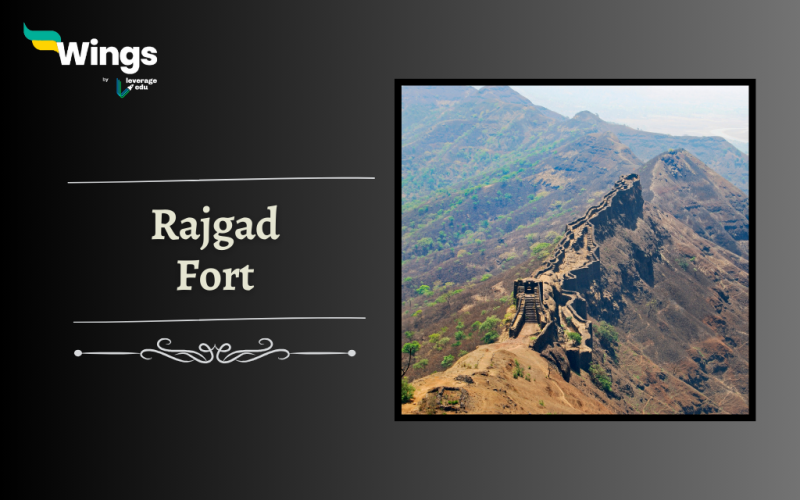Rajgad Fort is located in the Pune district of Maharashtra, India. It is a majestic fortress that stands on the Sahyadri Mountain and is of immense historical significance in the Maratha Empire. It was built in the 17th century and was formerly known as Murumbdev. In this article, we delve into Rajgad Fort history, features, and intriguing facts and know more about the architectural marvel.
| Commissioned by | Chhatrapati Shivaji Maharaj |
| Also Known as | Ruling Fort |
| Location | Pune, Maharashtra |
| Timings | Open 24*7 on all days |
| Entry Fee for fort | No Entry Fees |
Table of Contents
The History of Rajgad Fort
- Rajgad Fort was initially known as Murumbdev and was captured by the Maratha ruler Chhatrapati Shivaji Maharaj in 1647.
- It served as the principal seat of the Maratha Empire for over 26 years before the capital was shifted to Raigad Fort.
- It served as a base for several military campaigns and was instrumental in defending the Marathas against enemy forces.
- The fort is built at above sea level of 1,395 meters and thus is a difficult task to siege the fort.
- The fort is designed with multiple layers of fortification, bastions, and gateways, making it an impregnable structure during wars.
- Rajgad Fort witnessed several historical events, including the coronation of Chhatrapati Shivaji Maharaj.
- Shivaji’s wife Maharani Saibai also died in the fort in the year 1659.
- It was also the birthplace of Shivaji’s son, Rajaram Maharaj in the year 1670, who later became the ruler of the Maratha Empire.

Features of Rajgad Fort
- Balle Killa: Balle Killa, the central and highest part of Rajgad Fort, offers a panoramic view of the surrounding Sahyadri mountain range. It is home to several structures, including the Rajwada, the queen’s palace, and the famous Sanjeevani Machi. At the Mahadarwaja walls of Balle Killa, Shivaji buried Azal Khan’s head, a military general of the Adil Shahi dynasty.
- Sanjeevani Machee: It runs nearly 2 and a half km and possesses many cisterns. It is rumoured that an underground escape route is also under this mache which opens directly to the outermost fortification of the fort (though the passage is not accessible now).
- Padmavati Machee: Known for its sheer size and captivating beauty, Padmavati Machee served as the residence for the royal ladies and houses numerous residential buildings and water reservoirs with a small freshwater lake named Padmavati Lake. The machee also has the Padmavati Temple which is believed to have been constructed by Shivaji. In front of the temple is the tomb of Saibai along with Rameshwar Temple which has a Shiva linga till today and is believed to have been here since Shivaji’s times.
- Suvela Machee: Suvela Machee is an ancient fortification within Rajgad Fort that was primarily used as a watchtower and defence post. It is also known as Chor Darwaza. This section of the fort has “Hatti Prastar” or “Nedh”. There also is a doorway named “Madhe Darwaza”.
- Alu Darwaza: If one wants to come to Rajgad from Torna fort, this is the only entrance to the fort.
Also Read – Janjira Fort History: Features, Facts, Timings & More
Interesting Facts about Rajgad Fort
- Spread over an expansive area of approximately 40 acres, Rajgad Fort is one of the largest forts in Maharashtra.
- The fort boasts a total of three massive entrance gates namely Mahadarwaza, Palkhi Darwaza and Gunjavane Darwaza, all of which exhibit intricate architectural craftsmanship.
- The fort was retained by Shivaji Maharaj when he signed the Treaty of Purandar with the Mughal General Jai Singh I in the year 1665 who was serving under Mughal Emperor Aurangzeb. Because of this treaty, Shivaji had to give away 23 forts which he built over time out of 35 forts.
Also Read – Jaisalmer Fort History: features, Facts, Timings & More
Timings and Entry Fee of the Rajgad Fort
The fort is open to the public 24 *7 on all days and is a trekker’s spot for trek lovers. One can also stay inside the fort at night and there are no entry fees either.
Rajgad Fort stands tall with the glorious Maratha Empire and its indomitable spirit. It offers a fascinating glimpse into the grandeur of architecture and the defensive methods that Marathas adopted. Apart from the Maratha Empire, the fort also witnessed the reigns of the Mughal Empire, the Adilshahi dynasty, the Nizamshahi dynasty and at last it went to the Britishers.
Other Attractions near Rajgad Fort
| Torna Fort | Baneshwar Temple |
| Necklace Point | Pune-Okayama Friendship Garden |
| Sinhagad Fort | Rajiv Gandhi Zoological Park |
Relevant Blogs
| Kumbhalgarh Fort History | Amer Fort History |
| Chittorgarh Fort | History of Fatehpur Sikri |
| Agra Fort History | Golconda Fort |
| Bhangarh Fort History | Red Fort History |
That’s all about Rajgad Fort history! If you want to know more about topics like this, then visit our general knowledge page! Alternatively, you can also read our blog on general knowledge for competitive exams!
 One app for all your study abroad needs
One app for all your study abroad needs













